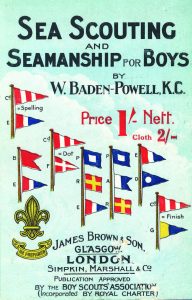- Author
- Book reviewer
- Subjects
- History - general
- Tags
-
- RAN Ships
- None noted.
- Publication
- September 2011 edition of the Naval Historical Review (all rights reserved)
We are only reviewing one book, a history of Sea Scouting. This volume is extremely well written by an author who has spent a lifetime involved in Sea Scouting and more than ten years researching this history. A fascinating story appealing to a wide audience which includes anyone interested in history, training and the sea, who should find this story thoroughly enjoyable.
Sea Scouting – A History 1909 – 2009 by Roy Masini. Published by Phillimore & Co Ltd, Andover, 2011. Hard cover, rrp £30.00, 270 pages, black and white and colour photographs.

This volume, providing a comprehensive history, is being launched in September 2011 as a tribute to one hundred years of Sea Scouting since the movement was formed in 1909. At this time, a year after Lord Baden-Powell established the Boy Scouts, his elder brother Warington Baden-Powell, who was a keen yachtsman and sailor, started the Sea Scouts. As a maternal grandfather had been an admiral, it was not unnatural for Warington to become a cadet in the training ship HMS Conway. From here he joined the Peninsula & Orient Line and qualified as a master mariner, and was also commissioned into the Royal Naval Reserve (RNR). He was to develop an interest in maritime law, qualify as a barrister and later be appointed a King’s Counsel. The foreword is provided by a third generation of this family, the Hon. Michael Baden-Powell, who is heir to the barony. Michael and his family live in Australia.
Sea Scouts have a long association with the Royal Navy as these youngsters with their keenly developed skills in seamanship, especially proficiency in boatwork, signalling and ship recognition, make excellent recruits. With the advent of WW I many Sea Scouts performed duties as coastal lookouts, thereby replacing the Coastguard when its members were recalled into Royal Naval service. In recognition of this contribution the Admiralty gave Sea Scouts access to certain naval training facilities while remaining independent of naval control.
A chapter of the book is devoted to Boy Seaman Jack Cornwall, who was a Scout but is revered in naval and Sea Scouting circles. Jack was stationed as a communications number at the forward turret of the light cruiser HMS Chester when she was heavily shelled during the Battle of Jutland. Although mortally wounded Jack remained at his post when all around him were either dead or dying. He became a great naval hero for his dedication and gallantry and was posthumously awarded the Victoria Cross.
Drawing attention to the inherent dangers in learning the seafaring profession, and the inadequacies at that time in safety equipment, there were a number of tragedies during the early years including the drowning of eight boys in a sailing accident off the north coast of Kent, known as the Leysdown Tragedy.
There were also the inevitable problems brought about by the Great Depression. During these times some common interests in youth training were shared with the regimes in Italy and Germany, with even MI5 keeping an eye on exchange programs. Sea Scouts were given fresh impetus in 1937 through the gift of the quaintly styled Royal Research Ship Discovery for use as a headquarters and training centre. She was in use for many years, moored by the Thames Embankment until 1955 when she was taken over by the RNR. The book notes Discovery’s history under the then Commander Robert Falcon Scott in his Antarctic Expedition. Later Discovery was lent to the Sir Douglas Mawson Expedition between 1929 and 1931.
During WW II the Sea Scouts were again involved in voluntary work assisting the armed forces, such as helping man the River Thames Emergency Services as signallers on launches and ambulance vessels assisting damaged ships and casualties. Sea Scouts also helped crew small craft involved in the evacuation from Dunkirk.
The organisation continues to flourish with some 450 Sea Scouts Groups throughout the United Kingdom encompassing about 10,000 members and many more world-wide. While the book touches on Scouting International it does not specifically mention Australia’s 150 Sea Scouts Groups with a total of about 4,000 members.
Reviewed by Liz Colthorpe




